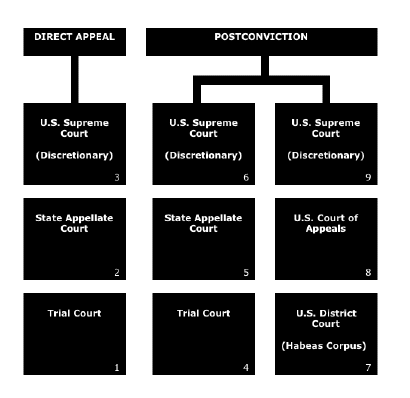Death Penalty Appeals Process

The Direct Appeal
The direct appeal is an automatic appeal given to everyone sentenced to death. The appeal is made to the state’s highest court in which someone can seek an appeal from a conviction and death sentence. In some states, this appeal is mandatory but in others, it is optional for the defendant.
The direct appeal is limited to issues from the trial. Typically, the prosecutor and the defense file briefs and oral arguments are held before a panel of judges. After reviewing the case, the judges can affirm the conviction and sentence, reverse the conviction, or reverse the death sentence.
The direct appeal for federal cases is also limited to issues from the trial, but is handled by federal courts, rather than state courts.
Either losing side can then petition for a writ of certiorari with the U.S. Supreme Court, requesting a review of federal constitutional issues.
State Post-Conviction
This is the second stage of the appellate process. Petitions are first filed with the original trial judge, then appealed to any intermediate courts (when applicable), and then finally to the state's highest court. At this stage, the defendant may raise issues surrounding the conviction and sentence that are outside of the record. The defendant can raise issues such as ineffective assistance of counsel, juror misconduct, newly-discovered evidence and Brady violations (A Brady violation occurs when the state withholds evidence that could help the defense's case). There are strict timelines that must be followed when filing this appeal, and missing a timeline may end a defendant's appeals. The defendant may again choose to petition the U.S. Supreme Court for a writ of certiorari. If the Court denies the writ, the defendant has exhausted all State remedies, and the case can be continued in federal court.
Federal Habeas Corpus
Federal habeas corpus is the final stage of the appeals process, and is limited to federal issues raised on appeal in the State courts. For federal death row inmates, this is the stage of the appeals process that allows them to raise issues outside the trial record. The federal appeals process consists of three levels.
A petition to the U.S. District Court is the first step in federal post-conviction review. The decision is made by a judge reviewing briefs filed by the prosecution and the defense. The judge may also grant a hearing on new evidence. The judge can dismiss the petition, overturn the conviction, or overturn the sentence.
Permission to appeal to the U.S. Court of Appeals is not automatic and must be granted by the U.S. District Court or the Court of Appeals. The appeal is limited to issues raised in the U.S. District Court. If the conviction or sentence is overturned in federal review, the state is usually given the opportunity to re-try the defendant. If the U.S. Court of Appeals denies relief, the only option is to petition the U.S. Supreme Court for a writ of certiorari.
The U.S. Supreme Court is the last resort for defendants appealing their death sentence. The Court, however, only reviews a handful of death penalty cases a year. When a writ of certiorari is denied by the U.S. Supreme Court, the defendant has exhausted his appeals. The only relief available to the defendant is executive clemency.
Executive Clemency
Executive clemency is the power held by a governor or other body to grant relief to a person facing execution. The governor may postpone an execution in order to allow time for further review or may commute a defendant's death sentence to a lesser sentence, such as of life without parole.
